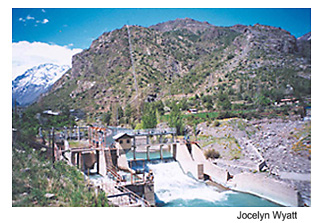USAID’s Changing Role in Global Water Resources Management
 |
This mountain waterpower station provides electricity to Chilean
residents. Over the years, USAID has shifted focus from building
infrastructure to helping governments and local communities
better manage all aspects of their water resources. |
USAID’s early involvement in water and water-related activities began in the 1960s with an emphasis on irrigated agriculture, community water supply, and a handful of large dam construction projects. These early efforts were relatively capital- and infrastructure-intensive, and included investment in such projects as Egypt’s Aswan Dam and Pakistan’s Tarbela Dam.
During the 1970s, the emphasis of USAID assistance shifted from dam construction towards community water supply and sanitation for health, and increased assistance to water user associations and community organizations in order to improve the provision of services and enhance civil society’s role in the water sector.
USAID responded to the international drinking water decade in the 1980s with the implementation of the Water and Sanitation for Health (WASH) program, which had as a major focus the improvement of child survival through clean drinking water supply, better hygiene, and enhanced wastewater treatment and sanitation.
In the 1980s, USAID evolved—with some exceptions in the Middle East—away from infrastructure projects. Watershed management within the context of forestry and/or agricultural received increasing attention, as did industrial pollution prevention. Environmental activities became legitimate ‘development objectives’ in and of themselves, and USAID began supporting coastal resources management in the 1990s for the first time. The increased focus on integrated water resources management (IWRM) in recent years reflects the growing consensus that access to adequate supplies of clean freshwater is essential to addressing the challenges in sustainable development faced by the global community.
Back to Top ^
|


